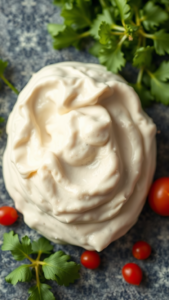Is Mayo Keto-Friendly? Understanding Its Nutritional Profile
When you embark on a keto diet, you’re often left wondering which condiments are acceptable and which are not. One common question that arises is, “Is mayo keto-friendly?” Mayonnaise is a staple in many kitchens and a favorite for dressings and dips, but it’s important to understand its nutritional profile to see if it aligns with your ketogenic lifestyle.
Mayonnaise is primarily made from three key ingredients: egg yolks, oil, and vinegar or lemon juice. The combination of these ingredients produces a creamy texture and a rich flavor that enhances a variety of dishes. But what does that mean for someone on a keto diet?
Nutritional Profile of Mayonnaise
First, let’s take a look at the nutrition facts of regular mayonnaise. The serving size is typically one tablespoon (about 14 grams). Here’s a breakdown:
| Nutrient | Amount per Serving (1 tbsp) |
|---|---|
| Calories | 94 |
| Total Fat | 10 grams |
| Saturated Fat | 1.5 grams |
| Carbohydrates | 0 grams |
| Protein | 0 grams |
From the breakdown above, it’s clear that mayo is high in fat and contains no carbohydrates, making it a suitable option for a keto diet. The keto diet requires you to significantly reduce your carbohydrate intake while increasing your fat consumption. Since mayo is high in fat and provides minimal carbs, it fits well into this high-fat, low-carb framework.
Are All Mayonnaise Products Keto-Friendly?
Not all mayonnaise is created equal. While traditional mayonnaise is keto-friendly, some varieties can include added sugars or fillers that increase the carbohydrate content. Here’s what to look out for:
- Low-Fat Mayonnaise: Often contains added sugars to replace the fat, making it higher in carbs.
- Flavored or Specialty Mayonnaise: Some flavors include sugar as a primary ingredient. Always check the label.
- Store-Bought Mayonnaise: Look for brands that explicitly say “sugar-free” or “keto-friendly.”
When selecting mayonnaise for your keto diet, read the ingredient list carefully. Look for options that consist mainly of oil, egg yolks, and acids like vinegar or lemon juice without unnecessary additives. Making homemade mayonnaise can also be an excellent alternative to control the ingredients.
How to Use Mayonnaise on a Keto Diet
Mayo into your diet can be delicious and versatile. Here are some ideas on how to enjoy mayonnaise while staying within your keto limits:
- Dressings: Mix mayonnaise with herbs and spices for a quick dressing for salads.
- Dips: Pair with vegetables like celery and bell peppers for a satisfying snack.
- Sandwiches and Wraps: Use mayonnaise in place of high-carb spreads in lettuce wraps or keto bread.
- Binding Agent: Use mayo in egg salads, chicken salads, or tuna salads to add creaminess.
Using mayonnaise can enhance flavors while keeping your meals aligned with keto principles.
Potential Health Benefits
Besides its great taste, mayonnaise can offer various health benefits when consumed as part of a balanced diet:
- Healthy Fats: The primary fat in mayo is often polyunsaturated or monounsaturated, which can support heart health.
- Vitamin E: Some oils used in mayonnaise are high in vitamin E, an antioxidant that supports immunity and skin health.
- Versatility: Adding mayo to meals can enhance flavors without adding carbs, making it easier to stick to your diet.
Mayo can indeed be a keto-friendly option. Just ensure that you choose the right type and use it wisely in your meals. Enjoy your keto journey while savoring the creamy goodness that mayonnaise can add to your diet!
Low-Carb Alternatives to Traditional Mayo
If you’re following a low-carb or ketogenic diet, you might be wondering about the condiments you can enjoy. Traditional mayonnaise is often a staple for many meals, but is it suitable for your dietary needs? The good news is that mayonnaise can fit your keto lifestyle, but if you’re looking for lower-carb alternatives or want to switch things up, there are plenty of delicious options available.
Understanding Mayo and Its Keto Compatibility
Traditional mayonnaise is typically made from egg yolks, oil, and vinegar or lemon juice. This combination results in a high-fat content while being low in carbohydrates—making it a great fit for the keto diet as long as you don’t consume it in excess.
However, it’s crucial to check the labels. Many store-bought mayo brands can include added sugars and unhealthy oils which might increase the carbohydrate count. Always opt for mayo that is low in carbs, or consider making your own at home for complete control over the ingredients.
If you’re feeling adventurous or simply want to try something different, here are some excellent low-carb alternatives to traditional mayonnaise:
- Avocado Cream – Blend ripe avocados with olive oil, lemon juice, and your favorite seasonings. This creamy mixture delivers healthy fats and is a fantastic mayo substitute.
- Greek Yogurt – Unsweetened Greek yogurt can be a great alternative with a creamy texture and tangy flavor. Simply stir in herbs or spices to customize it to your liking.
- Pesto – Basil pesto is not only flavorful, but it also contains healthy fats from olive oil and nuts. It works especially well as a spread on sandwiches or as a dressing for salads.
- Nut Butters – While almond or macadamia nut butter isn’t similar to mayo in flavor, it can add a rich and creamy texture to salads or sandwiches. Just be cautious about the carb count.
- Mustard – If you’re looking for a way to add zest, mustard adds flavor without the carbs. Look for varieties without added sugars.
DIY Keto Mayo Recipe
If you want to keep things simple yet delicious, making your own keto mayo is easy and allows for customization. Here’s a quick recipe:
Ingredients:
- 1 egg yolk
- 1 tablespoon Dijon mustard
- 1 cup avocado oil or olive oil
- 1-2 tablespoons vinegar or lemon juice
- Salt to taste
- In a mixing bowl, whisk together the egg yolk and mustard.
- Slowly drizzle in the oil while continuously whisking. This will create an emulsion.
- Add vinegar or lemon juice and salt to taste.
- Store in an airtight container in the refrigerator for up to a week.
Nutritional Comparison
| Type | Calories | Fat (g) | Carbohydrates (g) | Protein (g) |
|---|---|---|---|---|
| Traditional Mayo (1 tbsp) | 94 | 10 | 0.1 | 0.1 |
| Avocado Cream (1 tbsp) | 23 | 2.3 | 1.3 | 0.3 |
| Greek Yogurt (1 tbsp) | 9 | 0.4 | 1.1 | 0.9 |
| Pesto (1 tbsp) | 80 | 8.0 | 1.0 | 1.2 |
Final Thoughts
Choosing low-carb alternatives to traditional mayo allows you to enjoy flavor while staying true to your keto diet. Whether you decide to make your own, choose creamy avocado, or enjoy zesty mustard, you have many options at your disposal. Keep experimenting and find the ones that you enjoy the most!
How to Incorporate Mayo into Your Keto Meal Plan
Are you on a keto diet and wondering if mayo can fit into your meal plan? You’re in luck! Mayonnaise is not only low in carbohydrates, but it can also add a creamy texture and rich flavor to your meals. In fact, mayo can be a fantastic condiment for a variety of keto dishes. Here’s how you can incorporate mayo into your keto meal plan seamlessly.
Choosing the Right Mayo
When selecting mayonnaise for your keto lifestyle, it’s essential to choose the right type. Many commercial mayo brands contain added sugars and unhealthy oils that can knock you out of ketosis. Here are a few tips for choosing the best mayo for your keto diet:
- Look for Low-Carb Options: Check the nutrition label and choose a mayonnaise that has less than 1g of carbs per serving.
- Avoid Added Sugars: Make sure that no sugars are included in the ingredients list.
- Opt for Healthy Oils: Choose mayonnaise made with avocado oil or olive oil instead of soybean or canola oil.
Simple Recipes Using Mayo
Now that you have the right mayo, let’s explore some simple and delicious recipes you can try:
Keto Egg Salad
Egg salad is a classic dish that is easily customizable. Here’s how to make a keto-friendly version:
- 4 hard-boiled eggs, chopped
- 1/4 cup mayonnaise
- 1 teaspoon mustard
- Salt and pepper to taste
- Optional: chopped celery or onion for added crunch
Mix all ingredients in a bowl and enjoy it with lettuce wraps or on its own.
Keto Chicken Salad
This chicken salad can be a fantastic lunch option:
- 1 cup cooked chicken, shredded
- 1/3 cup mayonnaise
- 1 celery stalk, diced
- 2 tablespoons chopped pickles
- Salt, pepper, and a squeeze of lemon juice to taste
Combine all ingredients, and serve it on a bed of greens or in an avocado for extra healthy fats.
Using Mayo as a Base for Dips and Sauces
Mayo is a versatile ingredient that you can use as a base for various dips and sauces. Here are a few ideas:
Avocado Mayo Dip
Combine avocado, mayo, lime juice, salt, and garlic powder for a creamy dip perfect for veggies.
Herbed Garlic Aioli
Mix mayo with minced garlic, lemon juice, and your favorite herbs like dill or parsley to create an aioli that goes well with grilled meats or seafood.
Mayo into Your Snacks
Snacks can be a tricky part of the keto diet, but mayo can help you create tasty, satisfying options. Try the following:
Stuffed Avocado
Slice an avocado in half and fill the center with mayo mixed with diced tuna or chicken. Add a sprinkle of paprika for flavor.
Keto Deviled Eggs
Mix the yolks of boiled eggs with mayo, mustard, and paprika. Spoon or pipe the mixture back into the egg whites for a delicious snack.
Wrap Up Your Meals with Mayo
Using mayo can elevate your meals while ensuring that you stay within your keto macros. Here’s a quick guide on how much mayo you can use:
| Type of Meal | Recommended Mayo Serving |
|---|---|
| Salad Dressing | 2 tablespoons |
| Sandwich Spread | 1 tablespoon |
| Dips and Sauces | 1/4 cup |
Mayo into your keto meal plan is not only easy but also delicious. Just ensure that you pick the right products and get creative with your recipes!
The Role of Healthy Fats in a Keto Diet
Healthy fats play a vital role in a keto diet, primarily because they serve as the main source of energy when carbohydrate intake is minimized. Understanding the importance of these fats can help you make better food choices that align with your ketogenic lifestyle.
On a keto diet, the body shifts from using carbohydrates for fuel to relying on fats. This process, known as ketosis, requires you to consume a higher percentage of your daily calories from fats. But not all fats are created equal, and selecting the right types can be the difference between success and struggle on this diet.
Types of Healthy Fats
Choosing healthy fats is essential, as they provide numerous health benefits. Here are some common sources:
- Avocado: Rich in monounsaturated fats and fiber, avocados are excellent for heart health.
- Olive Oil: This oil is loaded with healthy fats and antioxidants, making it perfect for salads or cooking.
- Coconut Oil: Contains medium-chain triglycerides (MCTs) that the body easily converts to energy. Perfect for quick fuel!
- Nuts and Seeds: Almonds, walnuts, flaxseeds, and chia seeds are not only high in healthy fats but also low in carbs.
- Fatty Fish: Salmon, mackerel, and sardines are excellent sources of omega-3 fatty acids.
- Dairy Products: Full-fat cheeses, butter, and cream can add flavor and richness while remaining keto-friendly.
Benefits of Healthy Fats in a Keto Diet
Embracing healthy fats in your diet offers several benefits:
- Enhanced Energy: Fats provide a concentrated source of energy, offering more than double the calories per gram compared to carbs.
- Weight Management: Consuming healthy fats can help increase satiety, reducing the likelihood of overeating.
- Improved Mental Clarity: Fats, particularly MCTs, are known to promote brain health and improve focus.
- Balanced Hormonal Levels: Healthy fats support hormone production, which is essential for overall health.
How to Incorporate Healthy Fats
Here are some simple tips to include healthy fats in your daily meals:
- Drizzle Olive Oil: Use olive oil as a dressing for salads or drizzle it over roasted vegetables.
- Add Avocado: Include sliced or mashed avocado in salads, omelets, or as a spread on low-carb bread.
- Snack on Nuts: Keep some mixed nuts or seeds handy for a quick and healthy snack throughout the day.
- Cook with Coconut Oil: Use coconut oil for frying, baking, or roasting to add a delicious flavor.
- Include Fatty Fish: Aim to eat fatty fish at least a few times a week for their essential omega-3s.
Potential Pitfalls
While healthy fats are beneficial, it is essential to be cautious of a few pitfalls:
- Overeating: Even healthy fats contain a lot of calories, so moderation is key to avoid weight gain.
- Quality Matters: Processed fats, such as margarine and hydrogenated oils, should be avoided on a keto diet.
- Balance Your Intake: While fats are crucial, ensure you maintain a balance with protein and very low carbs for optimal results.
Healthy fats into your keto diet is not only essential for staying in ketosis but also for promoting overall health. With the right approach, you can fuel your body effectively and enjoy delicious meals that align with your dietary goals. Therefore, pay attention to the types of fats you choose and how they affect your health and well-being.
Homemade Mayo Recipes for Keto Enthusiasts
If you’re following a keto diet, you may be wondering about the compatibility of mayonnaise with your meal plan. The good news is that mayonnaise is a low-carb condiment, making it suitable for keto enthusiasts. In fact, homemade mayo can be a delicious and healthy addition to your diet, allowing you to enjoy a creamy texture without compromising your carb count. Here are a couple of simple homemade mayo recipes to help you stick to your keto journey.
Basic Keto Mayo Recipe
This basic homemade mayo recipe is quick to make, using just a few wholesome ingredients. It’s mayonnaise at its finest—perfect for slathering on sandwiches, mixing into dressings, or using as a dip.
- Ingredients:
- 1 large egg (room temperature)
- 1 tablespoon Dijon mustard
- 1 tablespoon white wine vinegar or lemon juice
- 1 cup light olive oil or avocado oil
- Salt to taste
Instructions:
- In a tall mixing jar, combine the egg, Dijon mustard, and vinegar (or lemon juice).
- Using an immersion blender, blend the ingredients for about 20 seconds until smooth.
- While continuing to blend, slowly drizzle in the olive or avocado oil. This should create an emulsion, turning the mixture creamy.
- Once all the oil has been added, continue blending until it reaches your desired consistency. Season with salt to taste.
- Transfer your homemade mayo to a clean container and refrigerate. Use within one week.
Garlic Avocado Mayo
This variation of mayo adds a delightful twist with the richness of avocado and the zing of garlic. Perfect for pairing with grilled meats or as a veggie dip!
- Ingredients:
- 1 ripe avocado
- 1 large egg (room temperature)
- 1 tablespoon Dijon mustard
- 1 tablespoon lemon juice
- 1 clove garlic (minced)
- 1 cup light olive oil
- Salt and pepper to taste
Instructions:
- Cut the avocado in half, remove the pit, and scoop the flesh into a tall mixing jar.
- Add the egg, mustard, lemon juice, and minced garlic.
- Blend with an immersion blender until smooth.
- While blending, slowly pour in the olive oil until the mixture is thick and creamy.
- Season with salt and pepper to taste, then transfer to a container and refrigerate.
Spicy Chipotle Mayo
If you’re a fan of a little heat, this spicy chipotle mayo will be your new go-to condiment. It brings a smoky flavor and a kick that works well in various dishes.
- Ingredients:
- 1 large egg
- 1 tablespoon Dijon mustard
- 1 tablespoon lime juice
- 1 cup light olive oil
- 2-3 chipotle peppers in adobo sauce (adjust for heat preference)
- Salt to taste
Instructions:
- Combine the egg, mustard, lime juice, and chipotle peppers in a tall mixing jar. Blend until smooth.
- Slowly drizzle in the olive oil while blending until you achieve the desired consistency.
- Add salt to taste and mix well, then store in the fridge for up to one week.
Storage Tips
When storing your homemade mayo, here are some tips to keep it fresh:
- Use a clean, airtight container to avoid contamination.
- Avoid exposing it to direct sunlight, as warmth can spoil the mayo faster.
- Always keep it refrigerated and consume within a week for optimal freshness.
By following these simple recipes, you can enjoy delicious homemade mayo that is perfect for your keto lifestyle. Not only do you control the ingredients, but you also avoid any hidden sugars or unhealthy fats found in some store-bought versions. Happy cooking!
Conclusion
Mayo can definitely find a place in your keto diet with its low-carb profile and high fat content, making it a worthy ally in your culinary endeavors. Its nutritional makeup allows you to enjoy creamy textures and rich flavors without compromising your dietary goals. For those seeking alternatives, there are several low-carb versions that cater to your needs, ensuring you never feel deprived.
Mayo into your keto meal plan is not only easy but can also enhance the taste of various dishes. From salads to dips and dressings, a little mayo can take your meals to the next level while keeping your carb count in check. Remember, healthy fats are the cornerstone of a successful keto lifestyle, offering fuel for your body and aiding in nutrient absorption.
For the adventurous home cook, homemade mayo recipes open up even more possibilities, allowing you to customize flavors and even experiment with additional herbs and spices. Making mayo at home also gives you complete control over the ingredients, ensuring it aligns perfectly with your dietary preferences.
So whether you choose traditional mayo or opt for low-carb variations, rest assured that you can enjoy this versatile condiment on your keto journey. Embrace the opportunity to enhance your meals with healthy fats and delicious flavors, proving that a keto diet can be both satisfying and enjoyable.




